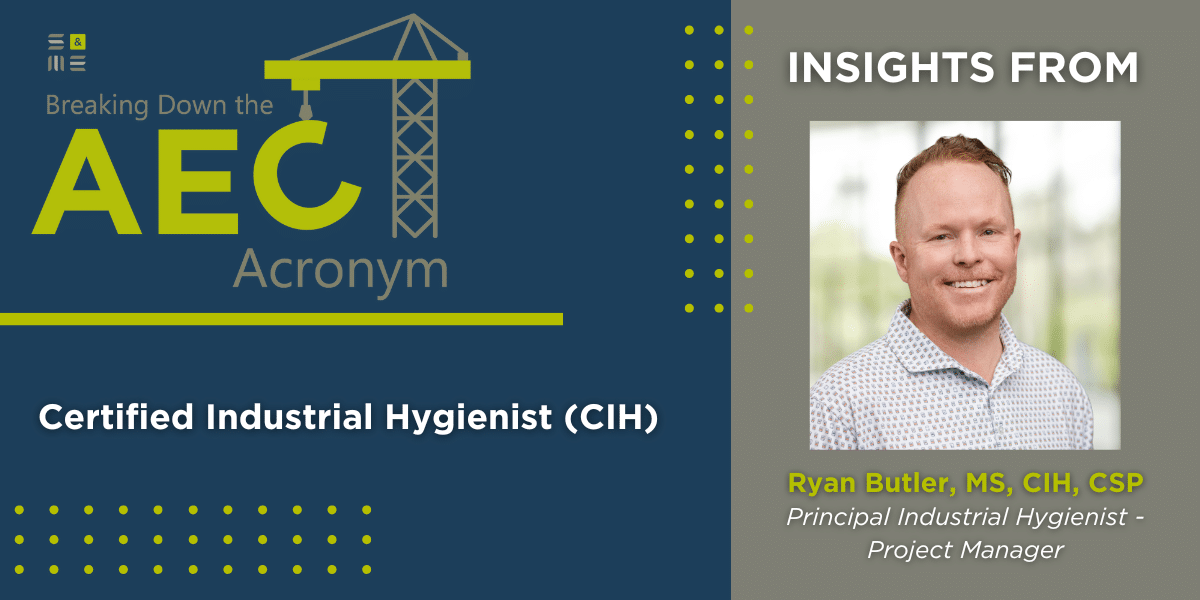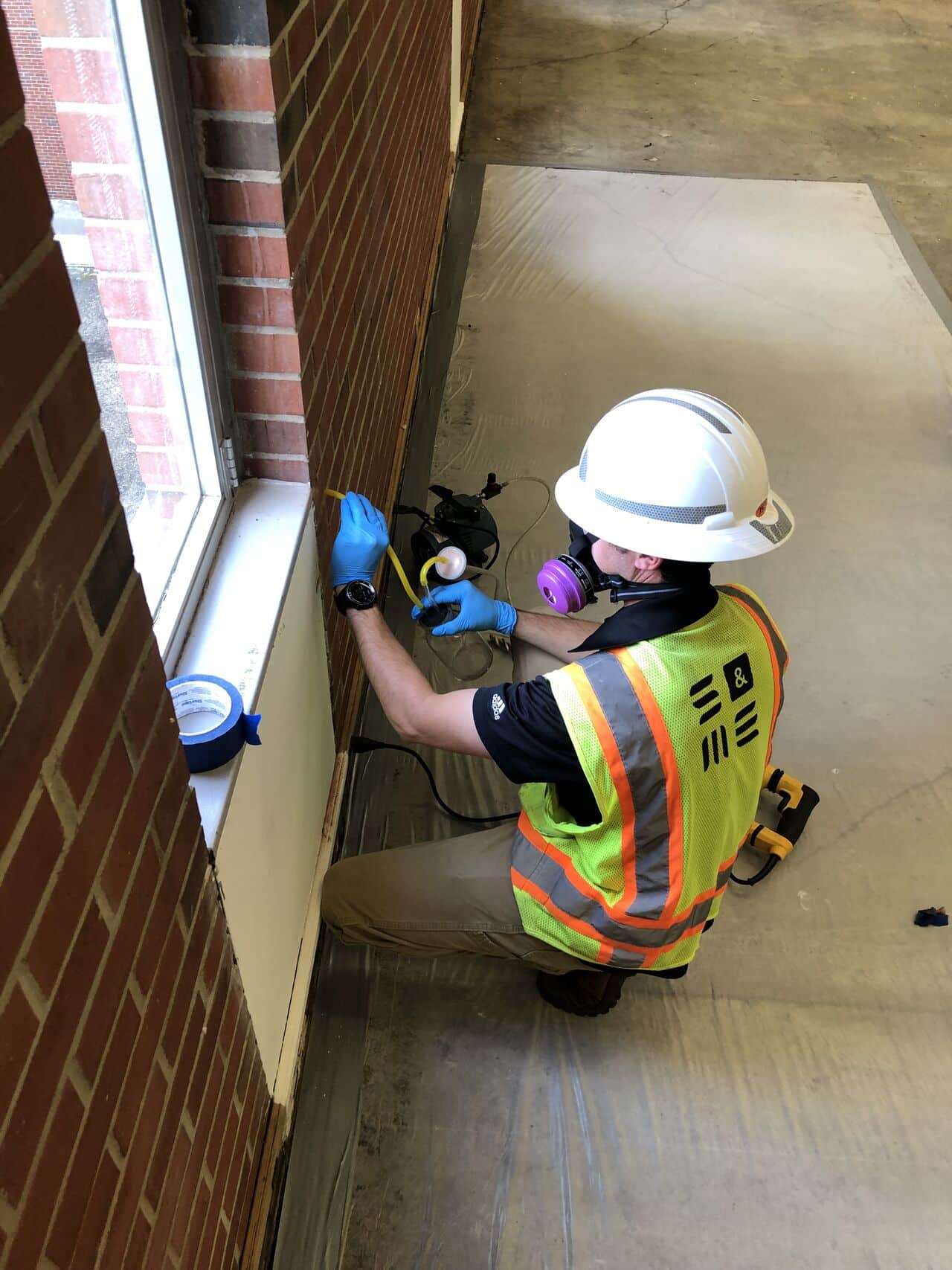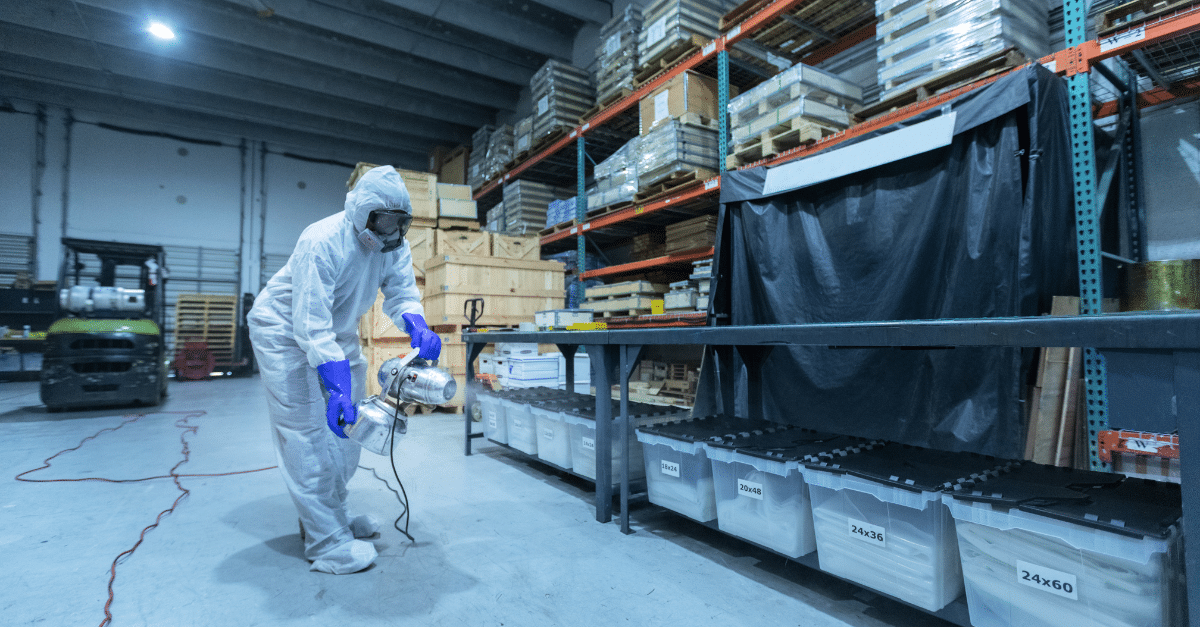May 21, 2025
If you’ve ever talked with an architect, engineer, or contractor you may find they use a lot of letters in their lingo. This campaign is an effort to demystify some of the commonly used acronyms in the Architecture, Engineering, and Construction (A/E/C) industry, what they mean, and why they are important.

What is a Certified Industrial Hygienist (CIH)?
A Certified Industrial Hygienist (CIH) is a professional who is certified to protect the health and safety of workers and the public by anticipating, recognizing, evaluating, and controlling various hazards. These hazards can be chemical, physical, ergonomic, or biological in nature. The CIH credential is considered the global standard for certification in this field.
Meet Principal Industrial Hygienist, Ryan Butler, MS, CIH, CSP
 We spoke with Ryan Butler, a Principal Industrial Hygienist and Senior Reviewer at S&ME, based in Charleston, South Carolina. He has over 24 years of experience in all facets of occupational, environmental, health, and safety (OEHS), with a demonstrated history of working in a wide variety of industries, including manufacturing, construction, industrial, maritime, residential, education, medical, and military.
We spoke with Ryan Butler, a Principal Industrial Hygienist and Senior Reviewer at S&ME, based in Charleston, South Carolina. He has over 24 years of experience in all facets of occupational, environmental, health, and safety (OEHS), with a demonstrated history of working in a wide variety of industries, including manufacturing, construction, industrial, maritime, residential, education, medical, and military.
In addition to the traditional OEHS expertise such as job hazard analysis, safety training, regulatory compliance audits, indoor environmental quality surveys, and hazardous substance exposure monitoring, Ryan possesses unique knowledge and experience with hazardous waste operations (HAZWOPER) operations, whole-body and hand-arm vibration exposure, post disaster safety, accident investigations, elevated blood lead level investigations, and confined space entry.
What inspired you to pursue this career?
“After countless stitches and broken bones, I finally decided I needed to add some risk management in my life and wanted to help others, which lead me to joining the Coast Guard. My initial career in the Coast Guard was a Marine Inspector, where I assessed commercial vessels for safety-related issues. One day during a chemical barge inspection, a CIH had to certify a confined space safe for entry, so I could inspect it. My initial thought upon hearing what this person did was, industrial hygienist, you clean teeth? Well, after I shadowed the CIH for the day, I learned they helped workers determine what hazards they are exposed to by assessing their workplace, anticipating and recognizing likely hazards, then evaluating them to determine the risk associated with each hazard and developing controls to reduce or eliminate the hazards. I like to think of it as a detective searching for clues, then putting the clues together to determine who or what is out to get you.”
What does the process look like to earn your CIH Credential?
 “To earn the CIH credential you have to have a minimum of a Bachelors degree, with 60 credit hours in STEM or an accredited industrial hygiene BS or MS, have specific IH classes or continuing education credits, four years of comprehensive IH practice, with experience in at least two of the four IH stressors (chemical, physical, biological or ergonomic), and pass a rigorous 200 question exam. To put it simply, it is a long journey, requires hard work and long hours, but it’s a rewarding one.”
“To earn the CIH credential you have to have a minimum of a Bachelors degree, with 60 credit hours in STEM or an accredited industrial hygiene BS or MS, have specific IH classes or continuing education credits, four years of comprehensive IH practice, with experience in at least two of the four IH stressors (chemical, physical, biological or ergonomic), and pass a rigorous 200 question exam. To put it simply, it is a long journey, requires hard work and long hours, but it’s a rewarding one.”
Can you share more about why the CIH Credential is valuable?
“Earning a CIH Credential puts you in an elite group of professionals, with less than 7,000 CIHs worldwide, and approximately 50% practicing in the United States, which gives you the status to control your career. It is the most sought-after occupational environmental health and safety credential there is.”
What are some of the most interesting or challenging projects you’ve worked on in your career?
“Every project in the world of comprehensive IH has its own challenges, making them all interesting in their own way. One day, I’m in a manufacturing plant assessing employee exposure to welding fumes, metal working fluids, and a variety of other chemicals while robots and people work in unison to manufacture vehicles, airplanes, golf balls, windows, fiber optic cable, fire retardant fabrics, and more.
The next day I’m at a Superfund site, trying to determine the likely chemical exposure that will occur during cleanup based on historical data, using real-time gas meters, and chemical class sorbent tubes to provide the most protective and appropriate personnel protective equipment for the cleanup crew.
I’ve assessed coroners for exposure to formaldehyde while they work in the morgue, nurses for exposure to a variety of chemicals while they dissect human organs in the pathology lab, construction workers for silica while building skyscrapers, and investigated how and where children were overexposed to lead.”
Can you share an example where your expertise helped solve a critical issue for a client or community?
“Each time I conduct a comprehensive IH assessment, I’m helping the client solve critical issues. Sometimes it can be as simple as adjusting where an employee stands when spray painting or sanding to reduce exposure by ensuring they don’t place themselves in line with where contaminants are being removed. Other times, I’m assessing their industrial ventilation systems, measuring airflow to ensure it meets applicable standards, and visualizing the airflow with smoke emitters to determine if the airflow is linear, so it properly removes contaminants from the workers’ breathing zone and directly into filtration systems. I help clients design ventilation systems to properly remove contaminants, workstations to reduce ergonomic hazards such as awkward postures, and develop work practices to reduce exposure.”
What advice would you give to those considering obtaining their CIH?
“The first thing I would do is reach out to a CIH to learn about the process, how long it took them, and what they had to do to meet the requirements. My journey took 10 years and two Master’s degrees to get everything I needed to meet the requirements and to develop the confidence that I was ready to take the exam. Don’t get discouraged, you may need additional school, continuing education, and specific work experience to get there, but it is worth it in the end.”
Key Projects and S&ME’s Expertise
S&ME works with a wide range of clients and industries, helping keep their employees safe by conducting comprehensive industrial hygiene assessments. We work companies such as Roper St. Francis Healthcare, Bosch, the College of Charleston, Mercedes-Benz Vans Charleston, and more, assessing employees exposure to a wide range of contaminants such as noise, welding fumes, various chemicals, ergonomic hazards, and more, while providing specific, practical and integral recommendations on how to control these exposures.

